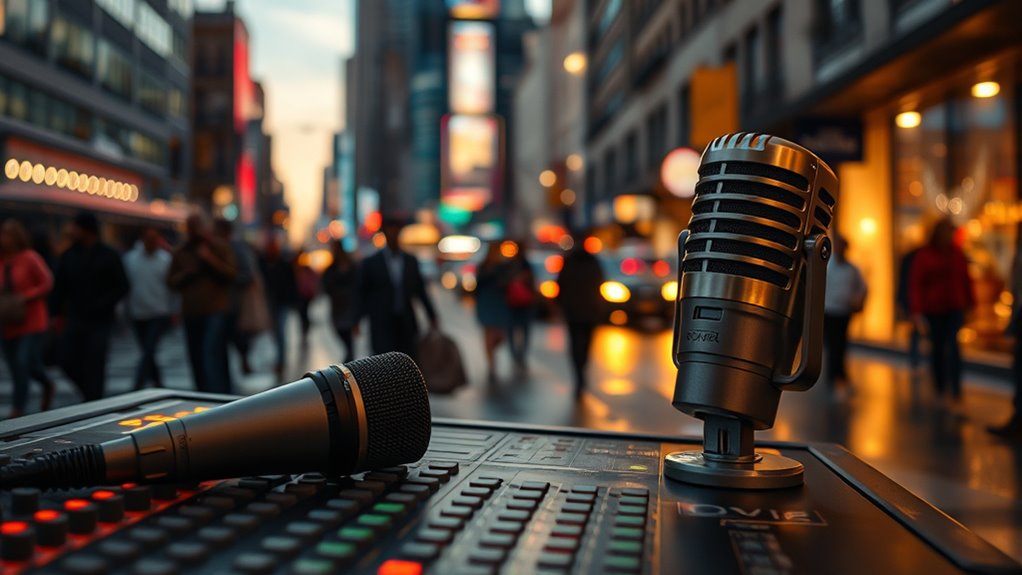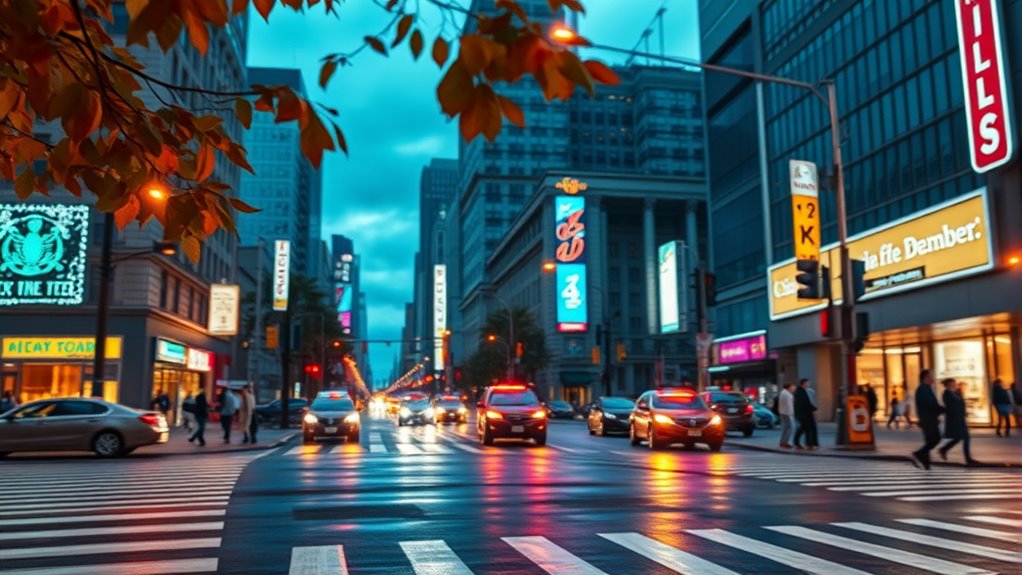To match ambient sound across mixed footage, start by analyzing the background noise and atmosphere in each clip. Use audio editing tools to adjust volume, EQ, and tonal qualities so that sounds blend seamlessly. Employ fades or crossfades for smooth shifts and consider adding reverb or spatial effects to create cohesion. Carefully balance layers to avoid muddy or inconsistent soundscapes. If you want to learn more techniques to achieve perfect continuity, continue exploring the details below.
Key Takeaways
- Use audio matching tools to automatically align ambient sound levels and tonal qualities across clips.
- Apply consistent EQ, reverb, and panning settings to create a uniform environmental soundscape.
- Incorporate crossfades and fades to smoothly transition ambient sounds between scenes.
- Match background noise characteristics by adjusting volume, frequency, and spatial placement for cohesion.
- Edit clips to reflect consistent time of day and weather conditions, ensuring ambient sounds feel connected.

Matching ambient sound involves selecting background noises that complement the environment or mood you want to create. When working across mixed footage, your goal is to guarantee that each scene flows naturally and feels cohesive, which makes sound layering a critical step. Sound layering involves combining multiple ambient sounds to build a rich, immersive audio environment. For example, if you’re working with outdoor footage, layering sounds like distant birds, rustling leaves, and subtle wind can help create a believable setting. However, it’s essential to balance these layers carefully. Too many sounds competing at once can overwhelm your audience, while too few might make the scene feel sparse or disconnected. The key is to find a harmony where each sound supports the others, enhancing the overall atmosphere without muddying the audio.
Audio consistency is equally important when matching ambient sounds across different clips. You need to assure that the background noise remains seamless, even if the footage was shot at different times or locations. If you don’t pay attention to audio consistency, viewers will notice abrupt changes in background sound, which can distract from the story you’re telling. To achieve this, try to match the volume levels, EQ, and tonal qualities of your ambient sounds throughout the project. For instance, if one outdoor scene has a slightly muffled wind sound, and the next features a sharper breeze, you’ll want to adjust the second clip’s audio so it feels like part of the same environment. Additionally, understanding the importance of audio continuity can help you maintain a cohesive soundscape, ensuring that transitions feel natural and unnoticeable. When mixing sounds from different sources, pay attention to how they blend together. Use equalization to match the tonal qualities, and consider applying fades or crossfades to smooth transitions. Additionally, editing your sound layers to match the time of day, weather conditions, or location can help maintain the illusion of continuity. This might involve subtly reducing or boosting certain frequencies or adding reverb to make different clips sound like they’re part of the same space. Recognizing the influence of ambient environment on sound design can further enhance the realism of your audio. Incorporating technological advancements, such as audio matching tools, can further streamline this process and improve your results. For example, some software now offers automated audio matching features that help to quickly align ambient sounds across scenes. Moreover, paying close attention to panning and spatial placement during mixing can enhance the realism and immersion of your soundscape. Remember, consistency doesn’t mean every clip has to sound identical, but they should feel connected within the same sonic landscape.
Ultimately, matching ambient sound across mixed footage demands careful listening and precise adjustments. Focus on creating sound layers that support your visuals, and keep your audio consistent throughout. When you do this well, your audience won’t notice the seams between scenes—they’ll simply become immersed in the story you’re telling, feeling like they’re right there with you in every environment.
Frequently Asked Questions
How Do I Handle Inconsistent Background Noise Levels?
When handling inconsistent background noise levels, you should use sound masking to create a more uniform audio environment. Apply noise reduction tools to minimize abrupt changes and unwanted sounds. Adjust the levels carefully so the background noise remains consistent, blending seamlessly across your footage. This technique helps maintain a natural flow, making the audio more professional and less distracting for viewers. Always listen critically to guarantee a smooth, balanced sound throughout your project.
What Tools Are Best for Syncing Ambient Sounds?
Imagine your audio landscape as a symphony waiting to be perfectly tuned. For syncing ambient sounds, use tools like iZotope RX or Adobe Audition’s sound layering features. These programs help with audio calibration, ensuring each sound piece fits seamlessly. By carefully aligning and balancing your ambient tracks, you craft an immersive soundscape that feels natural and cohesive, pulling your audience deeper into your story.
How Can I Improve Sound Continuity Across Cuts?
To improve sound continuity across cuts, you should focus on seamless audio transitions and sound masking techniques. Use crossfades or gradual volume adjustments to hide abrupt changes, ensuring smooth audio flow. Incorporate sound masking to fill gaps and maintain consistent ambiance. Pay attention to background noise levels and EQ settings, so passages feel natural. These methods help create a cohesive listening experience, making your edits less noticeable and more professional.
What Challenges Arise When Matching Sounds in Outdoor Footage?
When matching sounds in outdoor footage, you face challenges like background noise variability and maintaining soundscape consistency. You need to adapt to fluctuating ambient sounds, from wind to distant voices, which can disrupt audio continuity. You must carefully blend different audio layers, ensuring seamless shifts while preserving natural sound dynamics. This process demands keen attention to detail, patience, and skill to create a cohesive and immersive auditory experience.
How Do I Balance Ambient Sound With Dialogue?
To balance ambient sound with dialogue, you need to focus on effective sound layering. Start by lowering the ambient noise around the dialogue so it doesn’t overpower the conversation. Use noise reduction tools to clean up background sounds, ensuring clarity. Then, adjust the levels to smoothly blend the ambient sound into the scene, creating a natural atmosphere without distracting from the dialogue. This approach helps maintain a balanced, immersive audio experience.
Conclusion
In mastering matching ambient sound across mixed footage, you create a seamless symphony of scenes and sounds. By balancing background, bustling, and breezy elements, you craft a compelling, cohesive experience. Let your ears guide your edits, blending backgrounds beautifully and bringing balance to your footage. With careful consideration and creative consistency, you transform scattered sounds into a stunning soundscape, subtly shaping the story you tell. Ultimately, your attention to ambient accents amplifies the art of audiovisual alignment.









